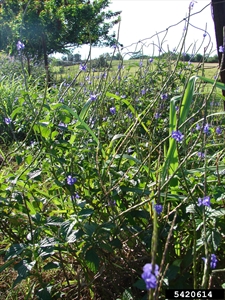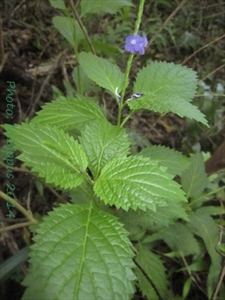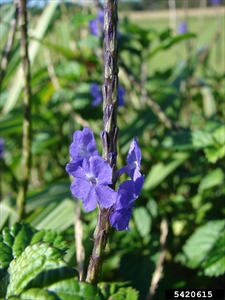Blue rat's tail; it is also known as dark blue snakeweed. CABI prefers the name rattail.
Pacific Pests, Pathogens, Weeds & Pesticides - Online edition
Pacific Pests, Pathogens, Weeds & Pesticides
Rat's tail (457)
Stachytarpheta urticifolia. It is a member of Verbenaceae.
There are a number of other Stachytaropheta species: Stachytaropheta cayennensis, Stachytarpheta indica, and Stachytaropheta jamaicensis. There has been considerable confusion and misidentifications between these. Some authorities think that Stachytarpheta urticifolia is the same as Stachytarpheta cayennensis, while others prefer to keep them separate - the flowers of Stachytaropheta cayennensis are pale blue to white.
Asia, Africa, North, South and Central America, the Caribbean, Oceania. It is recorded from Australia, American Samoa, Cook Islands, Federated States of Micronesia, Fiji, French Polynesia, Kiribati, Marshall Islands, New Caledonia, Niue, Northern Mariana Islands, Palau, Papua New Guinea, Samoa, Solomon Islands, Tokelau, Tonga, Vanuatu, and Wallis & Futuna.
Waterhouse & Norris state that the genus is of Central American origin; others consider that it is native to Asia and the Pacific.
An invasive weed of plantations, pastures, grasslands, forests and forest margins, secondary fallows, sand dunes, waste areas, and roadsides (Photo 1). A problem of disturbed land, although also invasive in cultivated and waste lands, as well as areas of natural vegetation. Its invasiveness is due to its production of large amount of seeds: one plant is able to produce more than 7000 seeds a year, with germination within 2 weeks.
A small, perennial shrub, usually 1-1.5 m tall, but occasionally up to 2.5 m. Stems are somewhat square in cross-section when young, greenish with purple tinge, becoming round and woody with age. Leaves, oval, 5-8 cm long and 3-6 cm wide, opposite along the stems, with a wrinkled surface, and saw-like margins (Photo 2). Flowers, dark blue, purple or violet, about 1 cm across, borne on spikes, 10-45 cm long and 1-3 mm thick, at the top of the stems, without stalks (Photo 3). Each flower has five petals fused together for part of their length to form a tube; inside the tube are two stamens (male parts) and a white style (female part). After flowering, the spikes become woody as the fruits develop within cavities along their length. Seeds are brown to black, 4-6 cm long.
Spread occurs by seed; these can be moved in soil, hay, and attached to animal fur, clothing and to machinery. Over long distances, spread has occurred with the use of the weed as an ornamental and its association with the international trade in plants. It might also be a contaminant of pasture seeds.
The weed can cause severe environmental impacts, particularly via its effective on biodiversity. It can compete with native species preventing their regeneration. In doing this, it is helped by the production of chemicals from the rat's tail that prevent the growth of other species as well inhibiting the germination of their seed.
Used to reduce fevers, as a tea to reduce blood pressure, and many other medical conditions.
BIOSECURITY
There is a high risk of introducing this weed. Countries not yet infested should consider all likely pathways for entry, and apply quarantine measures accordingly. Particular attention should be given to the risks associated with use of the plant as an ornamental, and as a contaminant of pasture seeds. Seed available on the internet.
Rat's tail is among the 10 worst weeds in American Samoa, French Polynesia and Solomon Islands, and important in Cook Islands, Guam, Papua New Guinea, and Tonga. It is one of the most common weeds of Fiji.
BIOLOGICAL CONTROL
Further information is needed on natural enemies in Central America.
CULTURAL CONTROL
- Physical & Mechanical
- Hand weed small areas is possible. Individual plants can easily be hand-pulled.
- Maintenance of pastures
- Do not overgraze. De-stock paddocks, adjusting to the carrying capacity of the land. Slash the weed and apply herbicide. Possibly, improve the pasture with recommended grasses and legumes to stop invading weeds.
- Hygiene
- Treat vehicles and farm machinery. Wash down vehicles first before moving from areas where the weed occurs to those weed-free. Wash to remove soil and seed.
- Ensure seeds are not carried on clothes between infested and 'clean' areas.
CHEMICAL CONTROL
Best control using herbicides is obtained by slashing or mowing plants and waiting for regrowth before treatment. In Australia, the following herbicides are registered for rat's tail: glyphosate (and Fiji); 2,4-D (check the various formulations); fluroxypyr; dicamba.
--------------------
Note, EU approval to use glyphosate ends in December 2022.
____________________
When using a pesticide, always wear protective clothing and follow the instructions on the product label, such as dosage, timing of application, and pre-harvest interval. Recommendations will vary with the crop and system of cultivation. Expert advice on the most appropriate herbicides to use should always be sought from local agricultural authorities.
AUTHORS Grahame Jackson, Aradhana Deesh & Mani Mua
Adapted from Dark blue snakeweed (Stachytarpheta cayennensis) (2018) Weeds of SE Qld and Northern NSW. Lucidcentral. (https://www.lucidcentral.org/editors-pick-animal-and-plant-identification-keys/key-to-weeds-of-se-qld-and-northern-nsw); and additional information from CABI (2019) Stachytarpheta urticifolia (rattail). Invasive Species Compendium. (https://www.cabi.org/isc/datasheet/117323); Waterhouse DF, Norris KR (1987) Stachytarpheta urticifolia. Biological Control Pacific Prospects. Inkata Press, Melbourne; and Stachytarpheta cayennensis (2019) Wikipedia. (https://en.wikipedia.org/wiki/Stachytarpheta_cayennensis); and from Snakeweed Stachytarpheta spp. (2020) Queensland Government. (https://www.daf.qld.gov.au/__data/assets/pdf_file/0005/54392/snakeweed.pdf). Photos 1&3 Forest & Kim Starr, Starr Environmental. Photo 2. Tonton Bernado. Stachytarpheta urticifolia (Verbenaceae).
Produced with support from the Australian Centre for International Agricultural Research under project HORT/2016/185: Responding to emerging pest and disease threats to horticulture in the Pacific islands, implemented by the University of Queensland, in association with the Pacific Community and Koronivia Research Station, Ministry of Agriculture, Fiji.






